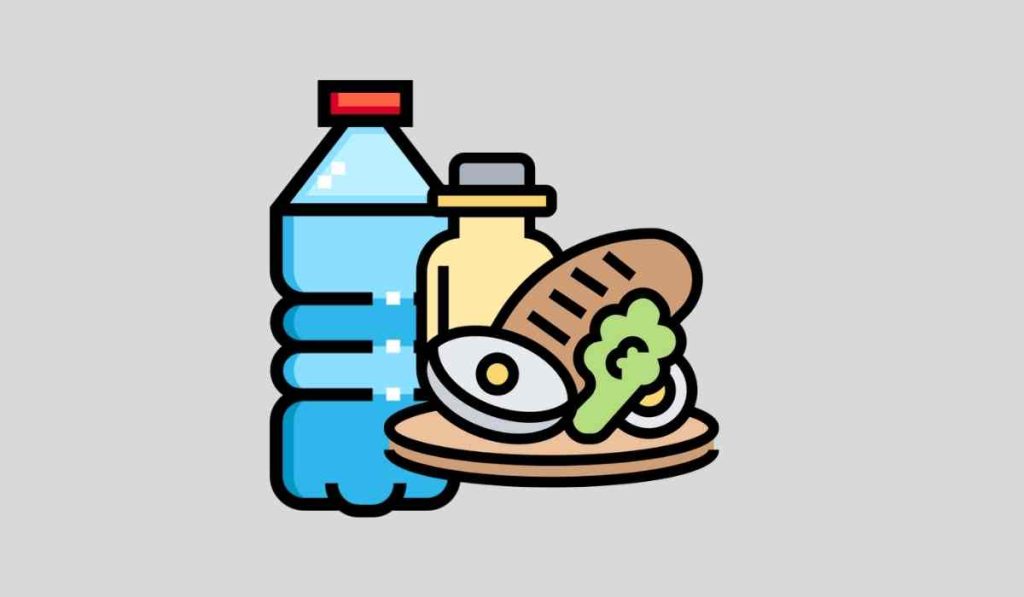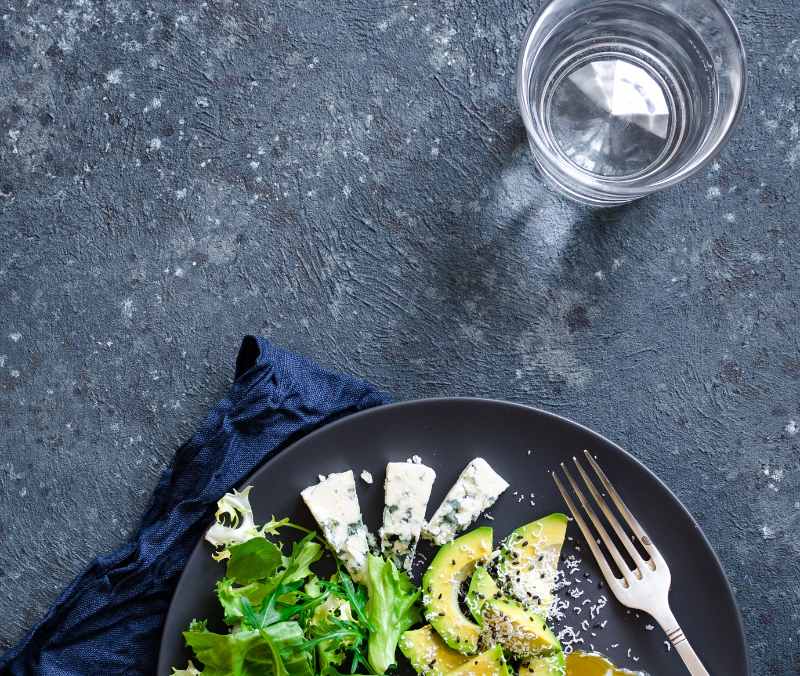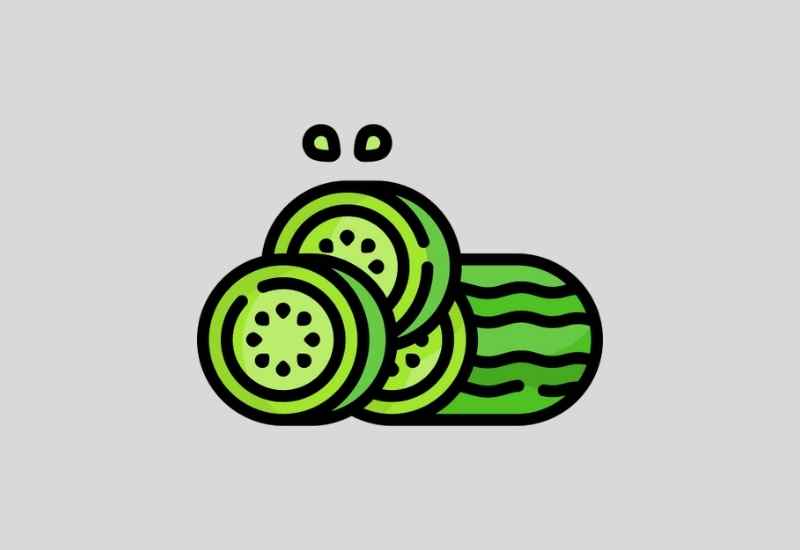Staying properly hydrated helps you stay in ketosis and speeds up fat breakdown. Here’s a detailed look at how much water you should drink on the keto diet.

The Ketogenic Diet, or “Keto Diet”, has remained a cornerstone fat-loss method for many bodybuilders and fitness enthusiasts for over the last couple of decades.
However, in the last few years, it’s exploded in popularity around the world with folks who want to get lean!
While the benefits of the keto diet are scientifically and anecdotally backed, it’s important to make sure you’re drinking the right amount of water to minimize potential risks.
So, grab that bottle of water and let’s hop right in, because we’re going to cover it all!
The Keto Diet – Overview
Now, before we get any further, let’s first cover what the Keto Diet actually is.
In brief, it’s a diet that’s low in carbohydrates, and high in fats and protein. This is quite the variation from our modern-day society’s cuisine, which is typically very heavy on carbs (ahem, sugar).
By consuming carbs, we get glucose: our body’s main source of energy.
See also: How Much Sugar Can You Have on Keto?
It’s basically the gas that keeps the car running. Take those carbs away (or greatly reduce intake), and our bodies produce what’s been described as “an alternative fuel called ‘ketones’ produced from stored fat”.
When this happens, it actually results in a loss of water and electrolytes, which can lead to dehydration.
How?
Because once the body starts producing ketones, it has to work to get rid of them.
Which is why hydration is so crucial.
The Importance of Hydration on Keto
One of the main exit routes is through increased urination, and if that water isn’t replaced, you can become dehydrated.
Not only that, but when carb intake is low, insulin production is also low. Low insulin can help burn fat, but also increase water, sodium, and potassium loss through urine.
This doesn’t mean you should just go mindlessly pounding jugs of water, though. Consuming too little water ends up in dehydration, but too much could dilute blood sodium levels, bringing along symptoms of Keto flu.
Even slight dehydration can cause fatigue, headaches, nausea, foggy brain, diminished athletic performance, and an array of other symptoms that could make you feel downright lousy.
Research even suggests that those on Keto may be at an increased risk of developing kidney stones, if they do not consume enough water.
By consuming enough water, you will lessen the stress on your kidneys.

How Much Water Should You Drink on Keto?
So, let’s get down to brass tacks – what actually is considered “enough water”?
Well, staying hydrated on Keto means two things:
- Drinking to thirst
- Getting enough electrolytes
Drinking to thirst means you’re neither dehydrated nor overhydrated. It means getting just the right amount of water and balance of electrolytes for your body.
In the past, it was suggested to drink 8 glasses of water a day, or to follow a specific number of ounces or liters a day. We now know that this is a bit of “pseudo-wisdom”.
The answer is much more complex, as it depends on so many factors:
- Physical activity level
- Height and weight
- Elevation
- Hormonal imbalances
…and so much more.
A sedentary person who weighs 100 pounds and a professional athlete weighing 280 pounds are obviously going to have different hydration needs.
For more information on the importance of hydration for athletic performance, check out this detailed guide to hydration for athletes.
A great rule of thumb is to gauge how you’re feeling. Pay attention to your body for signs of dehydration:
- Is your urine darker?
- Is your mouth dry?
- Do you feel sluggish/foggy?
- Are you constipated?
- Do you have frequent headaches?
- Do you feel thirsty?
If the answer to one or more of these questions is “yes”, you may be dehydrated.
It’s also a good rule of thumb to drink water until your urine is a shade of light yellow or even clear. Make sure you’re not feeling thirsty at any point in time.
Getting enough electrolytes (sodium, potassium, magnesium) is equally as important as consuming enough water. Electrolytes maintain fluid balance in the body, but be careful not to focus solely on potassium and magnesium.
(Electrolytes are also one of my favorite keto supplements for getting into ketosis faster and staying there.)
Many have the misconception that salt is “bad”, and this just isn’t true.
Sure, many “unhealthy” foods are loaded with sugar and/or vegetable oils which are usually high in salt. On Keto, you’re going to be eliminating a lot of those high-sodium, processed foods.
Remember what we said earlier – low insulin also means our bodies flush out more sodium.
By further restricting your sodium intake, you could put yourself at potential risk of everything from weakness and cramps, to fatigue and aches (or worse).
Being aware of electrolyte levels – especially salt – is crucial for optimal health.
Many people follow a Keto diet for weight loss, and are worried they’ll gain “water weight”.
But the reality is that drinking water will actually help with weight loss efforts.
Water is required to break down fats, so in order to metabolize fats faster, proper hydration is necessary. Not only that, but dehydration can make you have sudden sugar cravings. Stay satiated by avoiding dehydration.
Now that you know why it’s important to stay hydrated on Keto and what that means, let’s go ahead and cover how to stay properly hydrated on Keto.
How to Stay Properly Hydrated on Keto
As with being successful in almost anything in life, consistency is key.
For most people on Keto, it seems to be easier to stay well-hydrated by drinking water at regular intervals. For example, drinking a glass of water with every meal or snack.
Here are a few other tips that can help you avoid dehydration:
⭐ Start your day with a glass of water. As soon as you wake up, try to down a glass.
⭐ Keep a bottle or glass of water near you at all times. One of the best “hacks” for proper hydration simply having a water bottle on you to remind you to stay hydrated.
⭐ Download a tracking app. This is a great way to visualize your water intake. There are also water bottles out there that can track your intake. Many keto programs and apps also help you track fluid intake.
⭐ Drink something other than plain water. There are plenty of drinks that work great for keto. Low-sugar broths and sports drinks are great. While coffee can have diuretic effects, it does have some hydration benefits and coffee is also keto-friendly.
While “drinking to thirst” is usually sufficient, there are certain cases where you’ll need to up your hydration.
Related: 5 Best Keto Pills for Supercharging Ketosis
For example:
- When working out in climates that are colder or higher-altitude than what you’re accustomed to
- Sweating profusely
- Exercising more than normal
For example, if you don’t usually exercise and you’ve started a new routine where you’re running in the heat outdoors, you’ll want to drink more water than what you’re used to.
Hitting the gym while transitioning into ketosis can also lead you to feel more “struggley” in the gym (yes, you can build muscle on keto), so pace yourself and maximize results by opting to drink electrolyte water instead of plain, old water.
In any case, it’s important to add sodium to your fluids. If you’re just consuming plain water without any electrolytes, it can dilute electrolyte levels in your body.
This can have the reverse effect of what you’re going for, and let’s be honest, no one wants that!
How to Stay Hydrated on Keto without Drinking More Water
While it may be the most obvious, drinking water isn’t the only way to stay hydrated. Eating foods with high water content is another great way to do so.
There are lots of foods that are good for keto and will help you increase your water uptake:
- Cucumbers
- Celery
- Leafy greens
- Lemons
- Limes
- Bell peppers
- Tomatoes
- Berries
Get double the benefits from leafy greens/spinach which have high magnesium and potassium content. Consuming fruits and veggies with water and fiber will help keep you from getting constipated, too.

If you aren’t a fan of drinking electrolyte beverages or adding salt to your water, you may choose to opt for some salted nuts and seeds.
Broth-based soups or even no-sugar-added pickles are a great idea! Pickles are cucumbers, after all, and contain a good amount of water!
As far as supplementation of magnesium and potassium goes, proceed with caution.
Supplementing magnesium has comparatively less risk than that of potassium. However, neither should be taken lightly.
Looking for a customized ketogenic plan that works for you and your dietary needs? Check out my review of Keto Custom Plan, a digital keto planning tool that gives you a complete keto diet plan in minutes.
For magnesium, the body rids itself of any excess, which is why it’s often used as a laxative in concentrated forms. That’s probably not what you’re going for though, so start slow and low with dosages.
With potassium, you have either potassium chloride or Cream of Tartar.
However, taking too much concentration potassium can be genuinely dangerous. It’s best to get your electrolytes from whole foods.
Why not try throwing in an avocado, salmon, broccoli, or spinach into your diet instead? They all contain a healthy amount of potassium.
As you can see, there are plenty of approaches to staying properly hydrated when doing keto.
The Bottom Line
Yes, the Keto Diet does require some planning and perhaps more awareness than many of us are used to.
No one wants to worry about wondering if they’re dehydrated or not.
However, as long as you’re listening to your body and incorporating foods and liquids with proper water and electrolyte content you shouldn’t have to worry.
If you can manage that, you’ll be well on your way to accomplishing your weight loss goals and improved health with Keto!
More Keto Guides and Resources
5 Best Ketone Test Strips (and Alternatives). Want to know if your keto diet plan is working and you are in ketosis? Remove the guesswork with the best keto test strips available online.
Keto Charge – A Keto Pill That Actually Works (Full Review). Curious if Keto Charge can help you get into ketosis faster and achieve your weight loss goals? Read on for a full review, including key features, and see if it’s right for you.